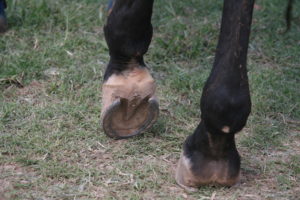At the barn where my daughter  rides we seem to be in the thick of abscess season. I have a few clients whose horses are suffering the same affliction too. Abscesses are one of the most common causes of acute lameness in horses, especially during the winter. This is a problem that almost all horse owners have dealt with, and if you haven’t, I can assure you that the first time it happens you will probably freak out when your horse comes up suddenly and violently lame. Abscesses are initially caused when bacteria enter the horse’s hoof. However, the horse does not show any lameness from an abscess until the infection reaches the sensitive part of the hoof and then they may act as though they have some horrendous injury.
rides we seem to be in the thick of abscess season. I have a few clients whose horses are suffering the same affliction too. Abscesses are one of the most common causes of acute lameness in horses, especially during the winter. This is a problem that almost all horse owners have dealt with, and if you haven’t, I can assure you that the first time it happens you will probably freak out when your horse comes up suddenly and violently lame. Abscesses are initially caused when bacteria enter the horse’s hoof. However, the horse does not show any lameness from an abscess until the infection reaches the sensitive part of the hoof and then they may act as though they have some horrendous injury.
So what exactly is an abscess? In simplest terms a hoof abscess is an accumulation of pus within the horse’s hoof. They can be relatively minor causing only mild lameness, or they can cause major discomfort due to the build-up of pressure in the horse’s hoof resulting in a horse that won’t put its foot on the ground.
Why does it seem that abscesses are more common during wet and muddy conditions or when the weather changes and what are other causes of abscesses?
Changes in weather conditions are one of the most common causes of an abscess. Wet conditions following dry weather often lead to abscesses. In dry conditions, the hoof is hard and often has small cracks in the sole. Once the weather becomes wet and muddy, the hoof expands and these small cracks in the hoof become a perfect place for bacteria to gain access which may lead to infection and an abscess.
An injury to the hoof can often predispose an abscess. If a wound penetrates the hoof wall or sole and allows the introduction of bacteria into the hoof capsule, these bacteria can lead to infection and an abscesses. However, the hoof doesn’t have to be penetrated. A bruised hoof can also cause an abscess. Bruises can turn into abscesses if the pocket of blood becomes infected by the bacteria forming an abscess.
Shoeing errors such as a hot nail. This happens when your farrier places a nail too close to the sensitive lamina tissue in your horse’s foot. This can introduce bacteria into the horse’s foot, resulting in an abscess.
Unsanitary conditions, such as dirty stalls or muddy pastures filled with urine and feces can also result in a hoof abscess. These conditions can soften and weaken the sole, making it more susceptible to bacterial penetration and infection.
Low grade laminitis. If your horse suffers from repetitive abscesses, it is worth discussing with your vet whether your horse may have on chronic low-grade laminitis. Or perhaps your horse tends to get abscesses in the fall, which may correspond with the seasonal rise in ACT hormone. This is especially elevated in horses with Cushing’s disease, which can lead to mild to severe laminitis. In laminitis the sensitive laminae are dying, which essentially results in dead tissue inside the hoof capsule that can result in the formation of pus and an abscess. If your horse gets repetitive seasonal abscesses, or just repetitive abscesses, it is worth checking with your vet to insure nothing more sinister is going on.
Treating the Abscess:
Ultimately, it is important to contact your veterinarian or farrier if you suspect that your horse may have an abscess for a proper diagnosis. In some cases, you may have to pull your horses shoe or have your vet or farrier pare away the hoof to give the abscess a better opportunity to drain. More commonly, the abscess will erupt on its own either out of the coronary band or the sole. However, here are some common practices, which may help the abscess erupt more quickly.
Prevention
Prevention is always the better choice! While in some cases it won’t be possible to prevent an abscess from forming, there are steps you can take: make sure stalls and runs are well mucked out and ideally graded so that they do not become too muddy, have a dry area where you horse can stand, be sure to pick out feet and check for injuries every day, and insure that your horse’s diet is well balanced especially for trace minerals. Zinc plays a vital role in the quality of hoof horn and diets are often low in zinc and have poor trace mineral balance. Insuring that there is a source of quality protein in the diet will also help hoof health as methionine, an essential amino acid, insures strong cross linkages in the horn.
Anyone who has dealt with a hoof abscess before knows that while it is frustrating to have your horse be out of work and in pain, there is also a sense of gratitude that it is just an abscess. Horses really can be a roller coaster of emotions and hoof abscesses are no exception!

Managing Hoof Abscesses by Summit Equine Nutrition is licensed under a Creative Commons Attribution-NonCommercial-NoDerivatives 4.0 International License.